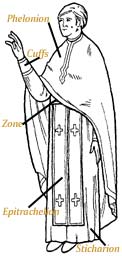
by the Very Reverend Michel Najim & T.L. Frazier"UNDERSTANDING THE DIVINE LITURGY"(A Guide For Participating In The Divine Liturgy Of St. John Chrysostom)
Vestments indicate the profession, rank, and dignity of the wearer. During the first centuries of the Church, the clergy basically wore normal clothing, though it was the best clothing possible as befitting the sacred functions of the clergy. There is some interesting mid-second century evidence, though, that hints that specifically liturgical clothing may have been worn even during apostolic times. In a letter to bishop Victor of Rome, Polycrates, a bishop in Asia Minor, wrote that the apostle John was “a priest wearing the breastplate (Greek: petalon).”35 The development of the specific liturgical vestments we know today started in the fourth century and continued to evolve until the ninth and tenth centuries. From the tenth to the thirteenth centuries, certain minor additions and alterations were made, but Orthodox vestments had for the most part settled into their present form around the end of the first millennium.
Orthodox vestments have a certain mystical significance, symbolically transforming the celebrant as he assumes them for liturgical use.36 Each of the individual vestments has its own significance.
The priest’s tunic, called a sticharion, is the “garment of salvation” and a “robe of gladness;” and donning it the priest is described in the Liturgy as being crowned according to the Oriental wedding rite. The sticharion is believed to have always been white with stripes running across the sleeves and the body. Over the course of the centuries it became more ornate, probably influenced by the Imperial prototype of the Eastern Roman Empire. The material used, though, was a matter of taste. Today the sticharion of a priest or bishop is a simple tunic reaching to the feet and is made of plain silk or satin. Putting on the sticharion, the priest cites Isaiah 61:10: “My soul shall rejoice in the Lord, for He has clothed me with the garment of salvation, and with the robe of gladness He has encompassed me. As a bridegroom He has set a crown upon me, and as a bride He has adorned me with an ornament.”
The liturgical significance of the stole is to show forth the grace of the priesthood. It is a double orarion (a long band of brocade) worn around the neck with both ends reaching down to the bottom of the sticharion. It is adorned with crosses and has a fringe at both ends. Symbolically, the stole represents the wings of the angels. It can also symbolize the robe of Aaron which was said to be fiery in appearance. The stole pictures the flesh of Christ as well, colored by His pure blood which He shed on the cross. Blessing the stole and kissing it, the priest puts it on, paraphrasing Psalm 133:2: “Blessed is God, who pours out His grace upon His priests, as oil of myrrh on the head, running down upon the beard, upon the beard of Aaron, running down over the fringe of his robe.”
The zone is a ceremonial girdle fastened at the back to hold the stole and the sticharion, thus facilitating bowing and kneeling. It signifies chastity, the mortification of the body, and the girding of the loins with the power of truth. Blessing the belt and kissing it, the priest puts it on, saying: “Blessed is God, who girds me with strength and has made my path blameless.”37
The two cuffs, which are embroided with crosses, are tied closely around the wrists so as to avoid interfering with liturgical activity.38 The prayers used when donning the cuffs glorify the hands of the Lord in creating humanity and in shattering His enemies. Blessing and kissing the right cuff, the priest quotes the Song of Moses from the book of Exodus: “Your right hand, O Lord, is glorified in strength; Your right hand, O Lord, has shattered Your enemies, and in the multitude of Your glory You crushed Your adversaries.”39 Blessing and kissing the left cuff, he recites a verse from Psalm 119: “Your hands have made and fashioned me; give me understanding and I will learn Your commandments."40
The epigonation is a square vestment suspended from one corner by a ribbon which runs across the chest from the left shoulder to the right side. While some believe that this ecclesiastical garment was simply borrowed from the Imperial uniform, it now has an altogether different and unconnected meaning: It represents the sword of Christ and His victory over death. A priest is granted the function of a confessor by receiving the epigonation in a special liturgical service. If the priest has the dignity of the epigonation, he blesses it and kisses it, reciting Psalm 45:3: “Gird Your sword upon Your thigh, O Mighty One, in Your comeliness and Your beauty, and proceed prosperously, and be king because of truth and meekness and righteousness; and Your right hand shall guide You wondrously.”
The phelonion is the outer garment covering the shoulders and is the chief vestment of a priest. Symbolically, it is the counterpart of the scarlet robe placed on Christ before the crucifixion.41 The unbelted phelonion on the shoulders of the priest also reminds us of Christ going to His crucifixion carrying the cross on His shoulders. Taking the phelonion, the priest blesses it, kisses it and puts it on reciting Psalm 132:9: “Your priests, O Lord, shall be clothed with righteousness, and Your holy ones shall shout for joy.”
35 Eusebius of Caesarea, Ecclesiastical History, 5:14:3.
==========================
36 Matthew 22:13. 37 Psalm 18:32. 38 Since there is little evidence that the cuffs were used in early liturgical services, some liturgists believe that the cuffs were later adopted in direct imitation of the Emperor. 39 Exodus 15:6.
40 Psalm 119:73.
41 Matthew 27:27-31. Cf. Mark 15:16-20.
Page created: 24-12-2012.
Last update: 24-12-2012.